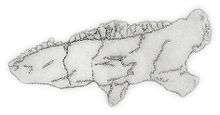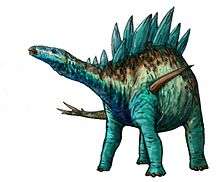Tatisaurus
| Tatisaurus Temporal range: Early Jurassic, Sinemurian | |
|---|---|
 | |
| Jaw | |
| Scientific classification | |
| Kingdom: | Animalia |
| Phylum: | Chordata |
| Class: | Reptilia |
| Clade: | Dinosauria |
| Order: | †Ornithischia |
| Clade: | †Thyreophora |
| Genus: | †Tatisaurus Simmons, 1965 |
| Species: | †T. oehleri |
| Binomial name | |
| Tatisaurus oehleri Simmons, 1965 | |
Tatisaurus is a genus of ornithischian dinosaur from the Early Jurassic from the Lower Lufeng Formation in Yunnan Province in China. Little is known as the remains are fragmentary.
Discovery and species
In 1948 and 1949 Father Edgar Oehler, a catholic priest working for the Fu Jen Catholic University at Beijing, excavated fossils near the village of Da Di in Yunnan. Among them was a jaw bone of a herbivorous dinosaur. In 1965 David Jay Simmons named and described it as the type species Tatisaurus oehleri. The generic name is derived from Da Di, then more usually spelled as "Ta Ti". The specific name honours Oehler.[1] The holotype, FMNH CUP 2088, was found in the Zhangjiawa Beds of the Lufeng Formation, dating from the Sinemurian. It consists of a partial left mandible with teeth. The lower jaw bone fragment is, lacking the tip, six centimetres long. The teeth are eroded. It is the only specimen known of the species.
Simmons assigned Tatisaurus to the Hypsilophodontidae, though this group was seen by him as an evolutionary grade of "primitive" Ornithopoda, ancestral to several ornithischian groups; he felt that Tatisaurus 's affinities were with Scelidosaurus or the Ankylosauria. Later, in 1990, the specimen was reviewed by Dong Zhiming who noted it had similarities with Huayangosaurus and placed it in the same subfamily, the Huayangosaurinae, hence making it a stegosaurian.[2]
Later still, in 1996, Spencer Lucas reclassified Tatisaurus as a member of the genus Scelidosaurus, thus as a S. oehleri, in order to use it for a biochron.[3] This has in 2007 been regarded by David B. Norman and colleagues as unfounded. They instead consider Tatisaurus to be a dubious basal thyreophoran, showing the thyreophorean synapomorphy of a ventrally deflected mesial end of the dentary. It would then be one of the oldest known Thyreophora.[4]
References
- ↑ Simmons D.J. (1965), The non-therapsid reptiles of the Lufeng Basin, Yunnan, China. Field Geol 15; 1-93.
- ↑ Z. Dong. (1990). "Stegosaurs of Asia". In: K. Carpenter and P. J. Currie (eds.), Dinosaur Systematics: Perspectives and Approaches, Cambridge University Press, Cambridge pp. 255-268
- ↑ Lucas S.G. (1996). The thyreophoran dinosaur Scelidosaurus from the Lower Jurassic Lufeng Formation, Yunnan, China. pp. 81-85, in Morales, M. (ed.), The Continental Jurassic. Museum of Northern Arizona Bulletin 60.
- ↑ Norman, David B.; Butler, Richard J.; Maidment, Susannah C.R. (2007). "Reconsidering the status and affinities of the ornithischian dinosaur Tatisaurus oehleri Simmons, 1965". Zoological Journal of the Linnean Society. 150 (4): 865–874. doi:10.1111/j.1096-3642.2007.00301.x.
- Dong Zhiming (1992). Dinosaurian Faunas of China. China Ocean Press, Beijing. ISBN 3-540-52084-8.
External links
- Tatisaurus at Thescelosaurus! (scroll to Thyreophora i.s.)

